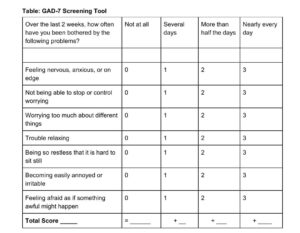Anxiety is a normal defensive mechanism of our body to cope with unwanted and threatening situations.
Everyone experiences anxiety at some point in their lives in response to physical and psychological stress.
According to DSM-5, the diagnosis of GAD is made when –
- Worry and anxiety present for almost six months about an event
- the individual finds it difficult to control the worrisome thoughts
- anxiety or worry is present with three or more out of the following six symptoms:
a) restlessness
b) easy fatigue
c) concentration difficulty
d) irritability
e) muscle tension
f) sleep disturbance
- Anxiety or physical symptoms cause significant impairment in multiple domains of life
- history of substance abuse or medical condition is ruled out
- disturbance not explained by other medical disorders such as OCD, PTSD, somatic symptom disorder, social anxiety disorder, and illness anxiety disorder
Patients usually present with –
- Physical symptoms:
a) palpitations
b) sweating
c) trembling or shaking
d) sensation of shortness of breath or smothering
e) feeling of choking
f) chest pain or discomfort
g) nausea or abdominal distress
h) feeling of dizziness
i) chills or heat sensation
j) derealisation and depersonalisation - along with excess out of control worry with irrational intrusive thoughts
A number of scales are available to diagnose and assess the severity of GAD. The GAD-7 has been validated as a diagnostic tool and a severity assessment scale, with a score of 10 or more having good diagnostic sensitivity and specificity. Greater GAD-7 scores correlate with more functional impairment.
Table: GAD-7 Screening Tool

Score 5: Mild
Score 10: Moderate
Score 15: Severe
Differential Diagnosis
Always rule out –
- Endocrine disorder:
a) hyperthyroidism
b) pheochromocytoma
c) hyperparathyroidism - Cardiopulmonary disorder:
a) arrhythmias
b) obstructive pulmonary disorder - Neurological disorder:
a) temporal lobe epilepsy
b) transient ischemic attack
c) psychological disorder
d) other anxiety depressive or bipolar disorders - also, rule out any history of substance abuse or withdrawal
Management
- lifestyle recommendations
- exercise, muscle relaxations
- mindfulness
- identify and remove triggers such as caffeine, nicotine and other stimulants
Medications
First-line treatments:
- Selective Serotonin Reuptake Inhibitor:
a) Escitalopram
b) Fluoxetine
c) Fluvoxamine - Serotonin Norepinephrine:
a) Duloxetine
b) Venlafaxine
Second-line treatments:
- Tricyclic anti-depressants:
a) Amitriptyline
b) Nortryptline - Anti-epileptic:
a) Pregabaline - Anti-psychotics:
a) Quetiapine
Third-line treatments:
- MAO Inhibitors:
a) Phenelzine
b) Isocarboxazine - Benzodiazepine:
a) Clonazepam
b) Alprazolam
c) Diazepam
d) Lorazepam
Psychotherapies and Relaxation therapies
Cognitive Behavioural Therapy: It’s cognitive helps with changing the thinking patterns and behaviour part helps with training patients to relax deeply. To make the process effective, the therapy should be patient-directed.
Mindfulness-Based Stress Reduction: This promotes attention to individuals’ present emotional state by various meditation techniques.
We should counsel the patients and their families and educate them that anxiety if treated properly with a good support system from the family, a patient can overcome anxiety.
None of the drug listed above should be taken without proper consultation of the doctor.This post is just for educational purpose and not for any clinical purpose.
Contributor- Dr. Yagika Pareek




Great write up Dr. ,Thanks for covering this topic
Very helpful
Great help
Amazing write-up Doc!❤️
Nice information
Woahhh!!!
Very Informative
Great information Dr
👍